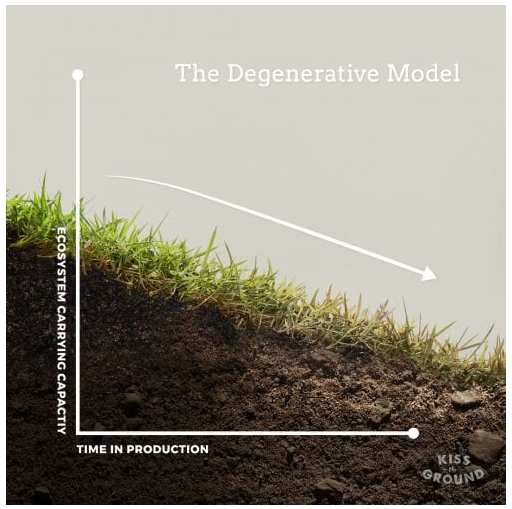What is Regenerative Agriculture, And Why Should We Care?
Regenerative Agriculture used to be called Sustainable Agriculture.
Sustainable Agriculture used to be called Agriculture.
Before the industrial revolution, agricultural practices were not as we know them today.
Today’s agricultural practices extract as much as possible from the soil, and depend on chemicals to provide what the soil cannot provide. This results in a very expensive agricultural model as chemicals are costly to apply and more land is needed to compensate for the reduced health of the soil.
Today’s agricultural practices are degenerative.
Additionally, today’s agricultural practices are causing much collateral damage including deteriorating human health, flooding events, nutrient deficiency in foods, habitat destruction, water pollution and many others.
Before the industrial revolution, agricultural practices regenerated soil.
What is regenerative agriculture?
Regenerative agriculture (“regen ag”) is a conservation and rehabilitation approach to food and farming systems.
Regen ag attempts to mimic nature as much as possible.
It focuses on topsoil regeneration, increasing biodiversity, improving the health and vitality of soil, improving water cycling, enhancing ecosystem services and carbon sequestration.
Notice the chocolate brown color of a regenerated soil
What are regenerative practices?
Regen ag practices:
· contribute to generating/building soils and soil fertility and health;
· increase water percolation, water retention, and clean and safe water runoff;
· increase biodiversity and ecosystem health and resilience;
· increase carbon sequestration.
Specifically, these practices include:
No-till
· Tillage breaks up (pulverizes) soil aggregation and fungal communities while adding excess oxygen (O2) to the soil for increased respiration and CO2 emissions.
· It can be one of the most degrading agricultural practices, greatly increasing soil erosion and carbon loss.
· A secondary effect is soil capping and slaking that can plug soil spaces for percolation creating much more water runoff and soil loss.
Soil fertility
· Improving soil fertility through the application of cover crops, crop rotations, compost, and animal manures which restore the plant/soil microbiome to promote liberation, transfer and cycling of essential soil nutrients.
· Artificial and synthetic fertilizers have created imbalances in the structure and function of microbial communities in the soil, bypassing the natural biological acquisition of nutrients for the plants, creating a dependent agroecosystem and weaker, less resilient plants.
· Building biological ecosystem diversity begins with innoculation of soils with composts or compost extracts to restore soil microbial community population, structure and functionality restoring soil system energy.
Livestock grazing
· Planning livestock grazing practices stimulate improved plant growth, increased soil carbon deposits, and overall pasture and grazing land productivity while greatly increasing soil fertility, insect and plant biodiversity, and soil carbon sequestration.
· These practices not only improve ecological health, but also the health of the animal and human consumer through improved micro-nutrients availability.
Why should we care how we farm/ranch?
Many of us farmers/ranchers have a passion for the land. Why would we continue destroying the land we are passionate about?
Many of us have children and grandchildren that will inherit and/or take over the land. Do we really want to leave it in worse condition than when we inherited and/or took over the land (because that’s what we’re doing with the current industrial practices)?
Regen ag requires less yearly inputs, making it a more profitable practice.
We would have to be deaf/dumb/blind not to see and realize that the trickling consequences of our current farming/ranching practices are affecting the weather, the economy, and our health.
Regen ag practices produce healthier livestock and products.
Do we really think we know it all, and that we can’t learn something new? It wasn’t too long ago that we thought the earth was flat!
Why not consider a different way of looking and doing what you love?
Infographics from Kiss The Ground

